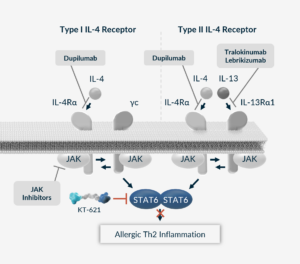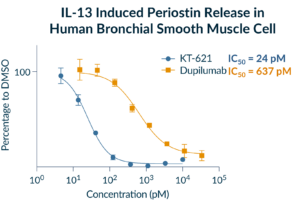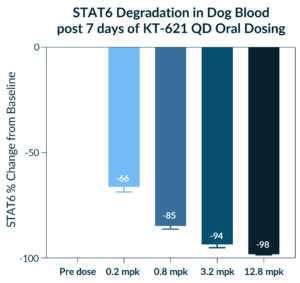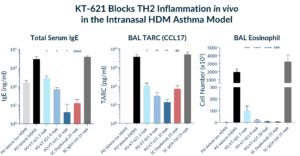
STAT6 Degradation: A Paradigm Shift in Immunology
We recently announced the first-in-human dosing of our oral STAT6 degrader, KT-621. While this is just the beginning of an exciting clinical journey, given the enormous potential of this program, it is also a moment to reflect on why and how we reached this important milestone and what we believe lies ahead. This is also a unique opportunity to celebrate another Kymera-first, with what we believe is the first STAT6 targeted agent (in this case degrader) to advance into clinical development.
STAT6: Reason to Believe
STAT6 is the perfect target for Kymera and is one that we have invested in tremendously to deliver a potentially paradigm changing oral drug in Th2 diseases for millions of patients around the globe. Here is why:
At Kymera we are driven by an unwavering commitment to go after targets, areas of biology and diseases that are not served by existing technologies and medicines. We focus on pathways with a high degree of clinical and genetic validation and targets that have not been drugged or drugged fully by any other technology and where protein degradation provides a unique solution to unlock disease biology and deliver groundbreaking medicines.
A few years ago, when we celebrated another industry first by bringing the first immune-directed heterobifunctional degrader to the clinic with our oral IRAK4 degrader KT-474, we learned two important lessons that have helped shape our strategy:
- Translation of degradation across all relevant immune cell types into the clinic can be accomplished very efficiently with the right investments in preclinical strategies that we put in place; and
- Degraders in immunology, unlike traditional small molecule inhibitors, can deliver the same level of pathway blockade of upstream biologics given their potent and catalytic mechanism that decouples PK from PD.
The prevalence of immune-inflammatory diseases, the clinical and commercial validation by several successful biologics, and the generally lackluster performance of traditional small molecule inhibitors, together with the learnings of our KT-474 program, were the key drivers of our decision to focus our R&D efforts towards the development of a new generation of oral degraders that would be able to compete with injectable biologics. At that time, we decided to do a deep dive on all pathways that had strong clinical and genetic validation but had not yet been drugged by an oral agent.
The IL-4Rα pathway quickly rose to the top of our list. This pathway controls two key cytokines, IL-4 and IL-13, that are central to Th2 inflammation.

Dupilumab, marketed as Dupixent, is a human monoclonal antibody that blocks IL-4Rα and in doing so blocks IL-4/IL-13 signaling very efficiently. Dupilumab is approved in a variety of Th2 diseases such as atopic dermatitis, asthma, COPD, chronic rhinosinusitis with nasal polyps, prurigo nodularis, and eosinophilic esophagitis, and has shown positive Phase 3 data in bullous pemphigoid. Unlike other IL-4 or IL-13 directed medicines, dupilumab has shown that it can address the broader inflammatory cascade in patients, including many of the comorbidities associated with Th2 diseases. This is an area of significant unmet need and dupilumab, the first injectable biologic approved in this space, has become one of the biggest mega-blockbuster drugs in our industry with projected sales of around $16.5 billion in 2025 (up from a projected $14 billion in 2024 and growing to a projected >$20 billion by 2030) (GlobalData 2024).
STAT6 is the selective transcription factor of the IL-4/IL-13 pathway and plays a critical role in translating the signal from the IL-4 receptor to the nucleus and in doing so drives Th2 inflammation. STAT6 also has strong human genetic validation showing that gain of function mutations cause severe, early onset allergic diseases. Being a transcription factor, STAT6 has been considered “undruggable” in the industry for the past 10 -15 years. Our rationale as we started this program was that degrading STAT6 with an oral agent would be able to block the pathway as effectively as upstream biologics, thereby delivering a dupilumab-in-a-pill profile.
More than 150 million people across the US, Europe, and Japan suffer from Th2-driven conditions (GlobalData 2024). However, less than 1 million of those patients receive dupilumab. Developing a first-in-class oral STAT6 degrader would give us an opportunity to create a revolutionary medicine with broad reach for Th2 inflammatory diseases and access for many more patients worldwide.
To summarize: we have a pathway with broad disease validation by a blockbuster injectable biologic, dupilumab, that has double-digit billion dollar sales; a potential addressable market that is >10x the one that dupilumab is currently addressing; and an intracellular node, STAT6, that has been considered undruggable by traditional small molecule inhibitors for many years. This is why this program is such a perfect fit for Kymera and such a great opportunity!
Pioneering STAT6
We’ll share more details on our STAT6 drug discovery story in the future, but I thought I’d share a few important lessons that I believe are widely applicable:
Building the Right Capabilities
Identifying ligands for difficult to drug proteins, such as transcription factors, requires best-in-industry capabilities.
I’ll admit, we didn’t have those in the first 2-3 years of the company. In fact, we screened many transcription factors with little success. It took capital, lessons learned, the right collaborators, and one of the best teams in this industry that we have built over the years to be in the position we are in today.
Over the past 3 years, for most if not all the target proteins we pursued, with the majority being transcription factors, we have been able to identify small molecule ligands.
Being the first company to develop effective, well tolerated, oral degraders in immunology gave us valuable insights on E3 ligase expression and pairing, kinetics, and PK/PD understanding that are needed to go after these types of central immune targets.
Our ability to optimize the chemistry to refine kinetics of degradation, thanks to a big investment we made in cryo-EM, ADME/PK properties, and importantly PK/PD translation, has allowed us to discover and optimize amazingly potent STAT6 degraders, the first of which is our clinical compound, KT-621, a picomolar, orally active investigational drug.
Building the Right Culture
We are a mission driven company that thrives on being challenged, doing things that have not been done before, and exploring the unknowns.
More importantly we are an organization that takes a science-first approach. Our rigorous scientific resolve is enabled by our open, inclusive and collaborative environment where our team feels comfortable bringing creative ideas to the table and challenging convention to navigate new frontiers in drug discovery and development. Out of many values and behaviors that are fundamental to our culture, I would highlight these three:
- Sense of urgency
- Truth seeking
- Challenging the status quo
Kymera has a unique culture that would deserve a whole blog post but for today I would just highlight that without a clear and resilient culture no company can grow to bring real medicines to patients.
Building the Right Data
Given the importance of this pathway and target we wanted to build the most comprehensive assessment of STAT6 biology, especially how it would compare to IL-4Rα blockade with the end goal of validating our hypothesis that targeting STAT6 would be able to phenocopy IL-4R targeting.
In order to develop an oral drug that could have biologics-like activity we decided that intrinsic potency had to be a key feature. KT-621, with DC50’s in the double-digit picomolar range, is one of the most potent degraders we have profiled at Kymera and more importantly, it retained the same degradation profile across all relevant human cell types with absolute selectivity. This exceptional potency profile and selectivity results in the ability to block IL-4/13 signaling in human cells much more potently than dupilumab. In the example here, we are able to block IL-13 in lung cells with IC50 that is more than 20-fold more potent than dupilumab. This is the first time in my career I have seen an oral molecule being intrinsically more potent than a monoclonal antibody.

In addition, at low daily oral doses, preclinical studies with KT-621 demonstrated full in vivo STAT6 degradation in disease-relevant tissues and was well-tolerated.

The exceptional potency and strong in vivo activity resulted in best-in-class efficacy in a highly translatable TH2-driven asthma model. In the intranasal house dust mite (HDM)-induced asthma model, KT-621 reduced all cytokine, cell infiltration, and disease severity readouts in the lung and bronchoalveolar lavage fluid comparable or superior to dupilumab.
We have shown in preclinical studies that KT-621 is more potent than dupilumab at blocking Th2 signaling in cell systems and equal or superior at blocking Th2 inflammation in preclinical disease models. We have also shown that KT-621 is well tolerated in all the safety studies that we have run in a wide variety of preclinical species, with no adverse events at any dose levels. Overall, the preclinical data generated to date demonstrate the opportunity for KT-621 to be a best-in-pathway medicine given its dupilumab-like activity and the convenience of an oral pill.
The novelty of our approach, impressive preclinical activity, and the potential to provide a convenient, first-line therapy for highly prevalent immuno-inflammatory diseases has generated considerable enthusiasm from our team and our community.
What’s Ahead for KT-621 and Kymera
As we have just started our first clinical study in healthy volunteers, we remain focused on our mission for this program.
The ultimate mission here is much bigger than just focusing on the drug development inflection points; in fact, it is to change the whole treatment paradigm for the millions of patients (>200 million worldwide) that suffer from Th2 diseases.
Our team has spent extensive time engaging with KOL’s, clinicians, and, personally, I have had the opportunity to talk with many parents of children with Th2 diseases and we feel the responsibility to deliver a game changing medicine here.
As mentioned earlier, there is a large delta between the number of patients with Th2 diseases and the population that has access to advanced therapies. For example, dupilumab penetration, just in AD is roughly 12%. The number of patients across several of these diseases is staggering. But only a small percentage get to access these highly effective advanced therapies while many others are left with medications that don’t address the underlying cause, Th2 inflammation, but only the signs and symptoms of the disease. For example, many patients use localized steroids (for AD) or inhaled (for Asthma and COPD) that are inconvenient, don’t address the root cause of disease, and can have a series of serious side effects.
Another important aspect of this disease landscape is that Th2 inflammation and its disease manifestations such as AD, asthma, EOE, CRSwNP, and others impacts a large percentage of younger patients. For example, out of the roughly 42 million patients suffering from AD, over 17 million of whom are children (GlobalData 2024), where research shows that injections are particularly difficult for kids, limiting their ability to be treated effectively. Having a convenient oral medicine could meaningfully improve the quality of life for these children and their families.
For these reasons, a once daily, oral STAT6 degrader, KT-621 has the potential to be a paradigm shifting medicine and change how Th2 diseases can be treated. Be the first-line therapy for patients across all Th2 disease and severities that actually addresses the underlying cause of the diseases. While for the past 20 years we have seen patients having to compromise on efficacy for convenience when transitioning from injectable biologics to oral small molecule inhibitors, we believe that KT-621 will be an example, the first of many from Kymera, where we can have both the efficacy of a biologic and the convenience of an oral pill.
As we advance this program through Phase 1 clinical testing in healthy volunteers, STAT6 degradation, safety, and tolerability will be the key readouts we look forward to sharing in the first half of 2025.
The work done by our team to progress this program from novel science to promising drug candidate was inspiring. Almost every day, I have watched, challenged and supported the STAT6 team and look forward to being an integral part of its progress as we enter its next stage of development. We know that success in biotech is never linear, and I’m sure we will have challenging times and difficult decisions, but I know that our unique culture, our truth-seeking behavior, our sense of urgency, and our science first approach will allow us to conquer the highest peaks.
As exemplified by STAT6, we have and will continue to break barriers at Kymera to deliver on our science, innovation, and commitment to patients. We are only at the beginning!
Nello
Nello Mainolfi, PhD
Founder, President and Chief Executive Officer
Kymera Therapeutics